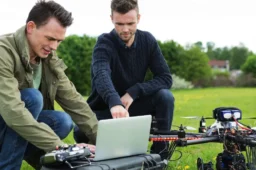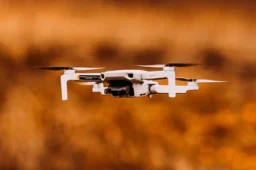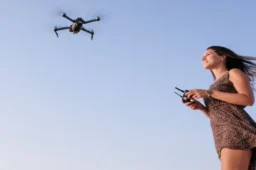
How Can Drones Improve the Safety of Pipeline and Power-line Inspections
How Can Drones Improve the Safety of Pipeline and Power-line Inspections. A Safety Game-Changer. Inspecting pipelines and power lines is a crucial yet often hazardous task. Traditional methods, like manual inspections and helicopters, come with inherent risks and limitations. But the rise of drones has brought about a paradigm shift, transforming these potentially dangerous jobs into safer, more efficient, and data-driven endeavors.
Here’s how drones are revolutionizing the safety of pipeline and power-line inspections:
1. Minimizing Human Risk:
-
Eliminating close proximity to danger zones: Drones keep human inspectors away from live power lines, high-pressure pipelines, and treacherous terrain, significantly reducing the risk of electrocution, falls, and exposure to hazardous materials.
-
Reduced reliance on heavy machinery: Drones eliminate the need for bulky bucket trucks and helicopters, minimizing the risk of accidents and environmental damage.
2. Enhanced Efficiency and Coverage:
-
Faster inspections: Drones can cover vast distances quickly and efficiently, completing inspections in a fraction of the time it takes traditional methods. This allows for more frequent monitoring and proactive maintenance.
-
Access to hard-to-reach areas: Drones can navigate intricate landscapes, tight spaces, and steep inclines, reaching areas inaccessible to humans or ground-based equipment. This ensures comprehensive inspections without compromising safety.
3. Superior Data Collection and Analysis:
-
High-resolution imagery and LiDAR: Drones equipped with advanced cameras and LiDAR sensors capture detailed images and 3D models of pipelines and power lines, revealing even the smallest defects and anomalies.
-
Real-time data processing and reporting: AI-powered software analyzes the captured data in real-time, providing inspectors with immediate insights and actionable reports, enabling faster decision-making.

4. Improved Predictive Maintenance:
-
Early detection of potential issues: Drones can identify subtle signs of wear and tear, corrosion, and other problems before they escalate into major failures, preventing costly repairs and service disruptions.
-
Proactive maintenance planning: The detailed data collected by drones helps utilities develop targeted maintenance plans, optimizing resource allocation and preventing unnecessary shutdowns.
The Future of Drone-Based Inspections:
The integration of advanced technologies like autonomous flight, beyond visual line of sight (BVLOS) operations, and even AI-powered defect recognition is poised to further enhance the safety and effectiveness of drone-based inspections. This will not only revolutionize pipeline and power-line maintenance but also pave the way for safer and more efficient inspections across various industries.
How Can Drones Improve Security
From border patrol to crowd control, drones are rapidly transforming the security landscape. Their unique aerial capabilities offer a bird’s-eye view that human patrols simply can’t match, making them valuable assets for a range of security applications.
Here are some key ways drones can improve security:
1. Enhanced Surveillance and Monitoring:
-
Vastly expanded coverage: Drones can patrol large areas quickly and efficiently, covering ground that would take ground patrols hours or even days. This allows for 24/7 monitoring of critical infrastructure, borders, and other sensitive locations.
-
Detailed data collection: Equipped with high-resolution cameras and sensors, drones can gather detailed data on the ground, including thermal imaging for nighttime monitoring and multispectral imaging for identifying specific objects or materials.
-
Real-time threat detection: AI-powered drones can analyze data in real-time, automatically identifying potential threats like intruders, fires, or hazardous materials spills. This allows for a rapid response to prevent or mitigate security incidents.
2. Improved Situational Awareness:
- Dynamic bird’s-eye view: Drones provide a real-time overview of a situation, giving security personnel a clear understanding of the layout, potential dangers, and escape routes. This can be crucial for coordinating responses to emergencies or managing large crowds.
- Reduced risk to personnel: Drones can be sent into dangerous or hard-to-reach areas, minimizing the risk of human injury during reconnaissance or search and rescue operations.
3. Streamlined Emergency Response:
- Faster incident assessment: Drones can quickly assess the extent of an emergency, such as a fire or natural disaster, providing valuable information for first responders to develop an effective response plan.
- Delivery of critical supplies: Drones can be used to deliver essential supplies, such as medical aid or communication equipment, to remote or disaster-stricken areas, saving lives and reducing response times.
4. Crowd Control and Public Safety:
- Monitoring large gatherings: Drones can be used to monitor large crowds at events or protests, identifying potential trouble spots and helping to maintain order.
- Traffic management: Drones can be used to monitor traffic flow and identify congestion or accidents, allowing for faster response and improved traffic management.
5. Cost-Effectiveness and Efficiency:
- Reduced manpower requirements: Drones can cover large areas and perform tasks that would require multiple human patrols, leading to cost savings and improved efficiency.
- Faster and more accurate data collection: Drones can collect data over large areas quickly and efficiently, providing valuable insights for security planning and decision-making.
However, it’s important to acknowledge the potential challenges and ethical considerations surrounding drone use for security:
- Privacy concerns: The widespread use of drones raises concerns about privacy and data security, as they can be used to collect vast amounts of personal data.
- Weaponization: The potential for weaponizing drones poses a serious threat, and regulations are needed to prevent their misuse.
- Safety risks: Drone malfunctions or accidents can cause injuries or property damage, and careful regulations are needed to ensure safe operation.
Final Words
How Can Drones Improve the Safety of Pipeline and Power-line Inspections. finally for the question, by minimizing human risk, enhancing efficiency, and providing superior data insights, drones are making these critical tasks safer, faster, and more reliable than ever before. As technology continues to evolve, we can expect even greater advancements in drone-based inspections, ensuring the safety and integrity of our vital infrastructure for years to come.





